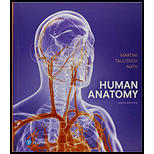
To review:
Match the term lobar bronchi with the most closely related description given below:
Superior portion of the pharynx
Bridge of the nose
Nose, nasal cavity, paranasal sinuses, nasal conchae, and nasopharynx
Windpipe
Lobar bronchi
Contains and protects the glottis
Larynx, trachea, bronchi, bronchioles, and alveoli of the lungs
Provide protection for the vocal folds
Positions and stabilizes the larynx
Segmental bronchi
Introduction:
Bronchi refer to the main pathway for the air to enter into the lungs. They become narrower and shorter as they get near to the lung tissue. Once they enter lungs, they are regarded as bronchioles. These bronchioles then evolve into the alveoli. Alveoli are tiny airbags and it is labeled as the primary site of gas exchange in the respiratory system.
Want to see the full answer?
Check out a sample textbook solution
Chapter 24 Solutions
Human Anatomy (9th Edition)
- When individuals are hyperventilating, they are told to breathe into a paper bag or into their cupped hands. (a) Explain why this increases blood carbon dioxide levels. (b) What will this do to the breathing rate?arrow_forwardGas exchange in the lungs takes place in the (a) alveoli, (b) bronchioles, (c) segmental bronchi, (d) lobar bronchi.arrow_forward7. The region of the thoracic cavity between the two lungs is called the .....................arrow_forward
- If there is decreased oxygen content in skeletal muscle tissue, arterioles supplying the skeletal muscles will ____. If there is decreased oxygen content in the alveoli, pulmonary arterioles will ____. Choose from the following: (A) dilate / dilate (B) constrict / constrict (C) constrict / dilate (D) dilate / constrictarrow_forwardAir moves into the alveoli as a result of the: (A)Decreased pressure in the chest cavity (B) Relaxation of the diaphragm (C) Rising pressure in the alveoli (D) Rising pressure in the chest cavityarrow_forwardWhen the inspiratory muscles contract, (a) only the lateral dimension of the thoracic cavity increases, (b) only the anteroposterior dimension of the thoracic cavity increases, (c) the volume of the thoracic cavity decreases, (d) both the lateral and the anteroposterior dimensions of the thoracic cavity increase, (e) the diaphragm bulges superiorly.arrow_forward
- Which one of the following is a possibility for most of us in regard to breathing, by making a conscious effort? Justify your option. a) One can consciously breathe in and breathe out by moving the diaphragm alone, without moving the ribs at all b)The lungs can be made fully empty by forcefully breathing out all air from them c)One can breathe out air totally without oxygen d) One can breathe out air through eustachian tubes by closing both the nose and the moutharrow_forwardA man gets stung by an insect leading to severe allergic reaction. He experiences shortness of breath and becomes unconscious. (a) Which type of shock does the man experience? Briefly describe and explain the change in peripheral resistance, blood pressure, blood volume and heart rate. (b) Suggest a medication that can treat this kind of shock and help the man to breath. Briefly explain how it works.arrow_forwardCallisto has managed to escape Xena, and therefore Xena decides to rest for the night in a small but deep cave at a high altitude in the mountains. (8.5 marks total, 300 words total max) a) Describe the changes in Xena's intrathoracic and intrapleural volume and pressure during quiet inspiration. Explain how these changes occur and describe their effect upon airflow. (4 marks) b) Explain how the rate of gas exchange between Xena's alveolar air and blood changes when she moves to high altitude and describe one possible compensatory change that occurs in her body as the consequence. (4.5 marks)arrow_forward
- The muscles attached to the ribcage and the diaphragm control the lungs'...a.) volumeb.) pressurec.) temperatured.) none of the abovearrow_forwardThe ventral respiratory group functions in Choose from the following: (A) normal inspiration / forced expiration (B) forced inspiration / passive expiration (C) forced inspiration / forced expirationarrow_forwardGas exchange at the blood air barrier is efficient because, (a) the differences in partial pressure are substantial. (b) the gases are lipid soluble. (c) the total surface area is large. (d) a, b, and c are correct.arrow_forward
 Human Physiology: From Cells to Systems (MindTap ...BiologyISBN:9781285866932Author:Lauralee SherwoodPublisher:Cengage Learning
Human Physiology: From Cells to Systems (MindTap ...BiologyISBN:9781285866932Author:Lauralee SherwoodPublisher:Cengage Learning
